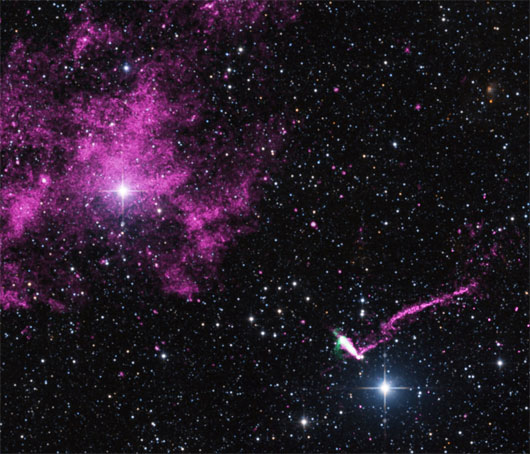Image of the longest stream of particles emitted by neutron stars
On Feb. 20, researchers working at NASA's Chandra X-ray observatory announced they had taken a picture of the longest stream of particle jets ever discovered in the Milky Way.
The stream of particles achieves such a great length thanks to its source, namely a neutron star named IGR J11014-6103 . This is also one of the neutron stars with the fastest movement speed ever discovered, and yesterday when it moved at 8 million km / h, it left this cosmic particle stream.

Neutron stars are formed in supernova explosions and are often symmetrical. So many neutron stars never leave the explosion area where they form. However, in some cases, the asymmetry in the explosion creates a repulsion on neutron stars and moves them away from the remnants of the explosion. In the case of IGR J11014-6103, the repulsive force makes it fly in space at speeds of 4 to 8 million km / h through which it becomes one of the fastest moving neutron stars ever found.
However, the observation at Chandra has shown that besides the high speed, this neutron star also possesses an unusual characteristic that when traveling, it creates high-energy particles that make it a pulsar. The flow of particles seems to be released in a direction perpendicular to the motion of the neutron star. In addition, the kink in the bead line suggests that the rotation of the neutron star's axis is unstable.
Subsequent observations may help elucidate asymmetric characteristics that cause neutron stars to be shot out at high velocities while also giving researchers a deeper understanding of the processes that create a supernova. fine.
- The gravitational wave suspected by the black hole swallowed the neutron star emitted
- What is a Neutron Star?
- Detecting new types of metabolism of neutron particles
- Roscosmos announces the sound of neutron stars
- The mystery is hard to explain around the curious neutron star
- The original gold smelter in the universe
- Finding strange stars Neutron is twice as massive as the Sun.
- Detecting unprecedented neutron stars, challenging the physical limit
- Discover the source of gravitational waves from neutron stars
- New discovery: Collisions of neutron stars produce heavy elements of strontium
- Video: The crazy dance of Vela neutron stars
- The thousand-star explosion shot gold, silver and platinum throughout the universe
 Van Allen's belt and evidence that the Apollo 11 mission to the Moon was myth
Van Allen's belt and evidence that the Apollo 11 mission to the Moon was myth The levels of civilization in the universe (Kardashev scale)
The levels of civilization in the universe (Kardashev scale) Today Mars, the sun and the Earth are aligned
Today Mars, the sun and the Earth are aligned The Amazon owner announced a secret plan to build a space base for thousands of people
The Amazon owner announced a secret plan to build a space base for thousands of people